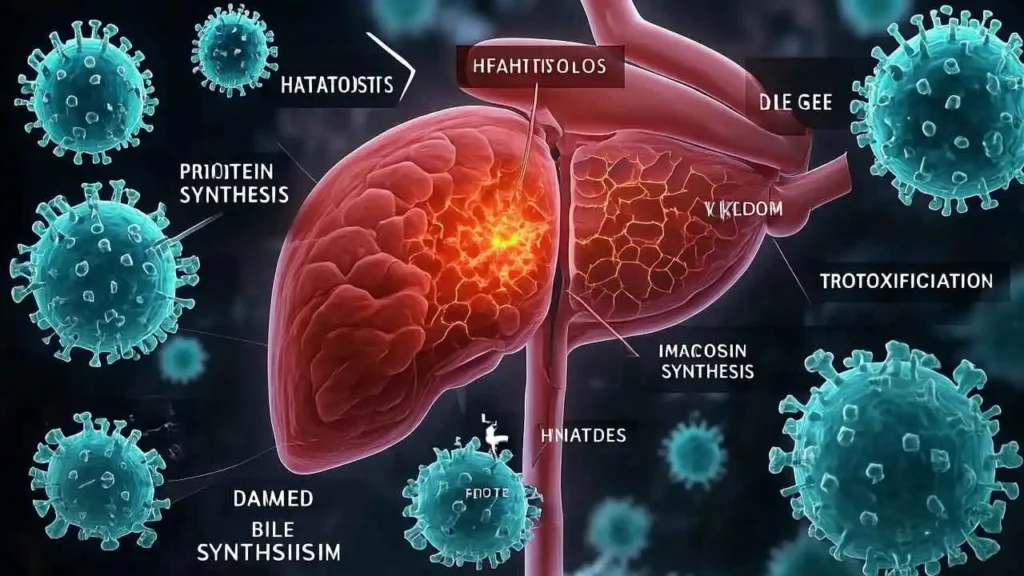
The Liver Under Attack: How Hepatitis Disrupts Vital Body Functions
Our bodies are intricate systems, and at the heart of our metabolic health lies a truly remarkable organ: the liver. It works tirelessly, filtering toxins from our blood, aiding in digestion, producing essential proteins, and storing energy. But what happens when this vital organ becomes inflamed? This condition, known as hepatitis, is a global health concern that affects millions. To protect ourselves and our communities, it’s crucial that we understand what hepatitis is, how it spreads, and how it can be managed.
In this comprehensive guide, we will journey through the complexities of hepatitis. We’ll explore its various forms, from the well-known viral types to lesser-known causes, and delve into the methods of diagnosis, treatment, and, most importantly, prevention.
What Exactly Is Hepatitis? A Comprehensive Overview
At its core, the term “hepatitis” simply means “inflammation of the liver.” The word itself is a combination of hepar (the Greek word for liver) and -itis (the common medical suffix for inflammation). The liver is a resilient and vital organ responsible for hundreds of essential functions, including filtering toxins from the blood, metabolizing nutrients, producing bile to aid digestion, and regulating blood clotting. When the liver becomes inflamed, its ability to perform these critical tasks is compromised.
This inflammation can be a short-term, or acute, issue that resolves on its own or with treatment over a few weeks or months. However, if the inflammation persists for six months or longer, it is considered a long-term, or chronic, condition. Chronic hepatitis is particularly dangerous because the persistent inflammation can lead to a gradual destruction of liver cells, causing irreversible scarring (fibrosis), which can progress to severe scarring (cirrhosis), and ultimately result in life-threatening complications like liver failure or liver cancer.
The Causes of Hepatitis: More Than Just Viruses
While many people associate hepatitis exclusively with a viral infection, it’s important to recognize that viruses are not the only culprits. The causes of liver inflammation are diverse and understanding them is key to prevention and treatment.
1. Viral Hepatitis
This is the most well-known cause. Several distinct viruses specifically target the liver. The five primary types are:
- Hepatitis A (HAV): Typically an acute infection spread through the fecal-oral route, usually via contaminated food or water. It does not cause chronic liver disease. Symptoms can be unpleasant, but most people make a full recovery. A safe and effective vaccine is available for prevention.
- Hepatitis B (HBV): Transmitted through infected blood, semen, and other body fluids. It can be an acute illness but has a significant chance of becoming chronic, especially in those infected at a young age. Chronic Hepatitis B is a leading cause of liver cancer worldwide. A vaccine is available and is a cornerstone of global prevention efforts.
- Hepatitis C (HCV): Primarily spread through direct contact with infected blood, most commonly through shared needles. Hepatitis C is often called a “silent epidemic” because it rarely causes symptoms in its early stages and is highly likely to become a chronic infection. It is a major cause of cirrhosis and liver cancer, but recent advancements in antiviral medications now offer a cure for most people.
- Hepatitis D (HDV): A unique “satellite virus” that can only infect people who are already infected with Hepatitis B. Co-infection with HDV and HBV can lead to a more severe and rapidly progressing form of liver disease.
- Hepatitis E (HEV): Similar to Hepatitis A, it is usually an acute infection spread through contaminated food or water. While it typically resolves on its own, it can be particularly dangerous for pregnant women and individuals with weakened immune systems.
2. Alcoholic Hepatitis
This form of hepatitis is caused directly by excessive and prolonged alcohol consumption. Alcohol is toxic to liver cells, and the process of metabolizing it creates harmful byproducts that trigger inflammation and fat deposition in the liver. Alcoholic hepatitis can range from a mild, reversible condition to a severe, life-threatening inflammation leading to acute liver failure. The most critical step in treatment is complete abstinence from alcohol.
3. Autoimmune Hepatitis
This is a chronic condition where the body’s own immune system mistakenly identifies its liver cells as foreign invaders and attacks them. This persistent assault causes ongoing inflammation and significant liver damage. The exact cause is unknown but is thought to involve a combination of genetic predisposition and environmental triggers. It is more common in women than in men, and treatment typically involves immunosuppressant drugs to calm the immune response.
4. Toxic and Drug-Induced Hepatitis
This type of inflammation occurs as a reaction to certain chemicals, medications, or supplements. The liver is responsible for processing almost everything you ingest, and some substances can overwhelm or directly damage its cells. Causes include:
- Overdoses of over-the-counter medications, such as acetaminophen (Tylenol).
- Reactions to certain prescription drugs, anesthetics, or antibiotics.
- Exposure to industrial chemicals like carbon tetrachloride.
- High doses of some herbal supplements, such as kava and comfrey.
Common Signs and Symptoms
Whether acute or chronic, hepatitis can present with a range of symptoms, although chronic cases may remain asymptomatic for years. When symptoms do appear, they often include:
- Fatigue and general malaise
- Jaundice (yellowing of the skin and eyes)
- Dark-colored urine and pale stools
- Abdominal pain or discomfort, especially in the upper right quadrant where the liver is located
- Loss of appetite, nausea, and vomiting
- Low-grade fever and joint pain
Because chronic hepatitis can progress silently, regular check-ups and blood tests are crucial for early detection, especially for individuals with known risk factors.
The Viral Culprits: A Breakdown of Hepatitis Types
Viral hepatitis is the most common form of the disease. There are five primary types, each caused by a different virus and differing in its mode of transmission, severity, and treatment.
| Hepatitis Type | Primary Transmission Route | Typically Acute or Chronic? | Vaccine Available? |
| Hepatitis A (HAV) | Fecal-oral (contaminated food or water) | Acute | Yes |
| Hepatitis B (HBV) | Blood, semen, and other body fluids | Can become chronic | Yes |
| Hepatitis C (HCV) | Primarily through blood-to-blood contact | Often becomes chronic | No |
| Hepatitis D (HDV) | Blood, semen, and other body fluids | Chronic (only infects those with HBV) | No (HBV vaccine provides protection) |
| Hepatitis E (HEV) | Fecal-oral (contaminated food or water) | Acute | No (in most countries) |
A Closer Look at Each Hepatitis Virus
While all forms of viral hepatitis involve inflammation of the liver, the five main viruses—Hepatitis A, B, C, D, and E—are distinct entities. They differ significantly in their genetic makeup, modes of transmission, severity, clinical outcomes, and the methods we use to prevent and treat them. Understanding these differences is crucial for public health, personal prevention, and effective medical care.
Hepatitis A (HAV): The Foodborne Virus
Hepatitis A is primarily transmitted through the fecal-oral route, meaning it spreads when a person ingests microscopic amounts of fecal matter from contaminated food, water, or surfaces. This often makes it an issue in regions with poor sanitation and is a common concern for travelers. Outbreaks can be linked to contaminated drinking water, raw shellfish harvested from polluted waters, or food prepared by an infected individual who didn’t wash their hands properly.
The illness caused by HAV is almost always acute, meaning it’s a short-term infection. Symptoms like fever, fatigue, nausea, abdominal pain, and jaundice (yellowing of the skin and eyes) can appear suddenly but typically resolve within a few weeks to months. Importantly, Hepatitis A does not progress to a chronic, long-term disease. Once a person recovers, their body’s immune system has successfully cleared the virus, granting them lifelong immunity. Prevention is straightforward: a highly safe and effective vaccine is widely available and recommended for travelers, children, and individuals in high-risk groups. Good hand hygiene remains a fundamental preventative measure.
Hepatitis B (HBV): The Persistent Threat
Hepatitis B is a bloodborne pathogen, transmitted through direct contact with infected blood or other bodily fluids, such as semen and vaginal fluids. Common routes of transmission include unprotected sexual contact, sharing needles or other drug-injection equipment, and from an infected mother to her baby during childbirth (perinatal transmission).
The outcome of an HBV infection largely depends on the age at which a person is infected. While most healthy adults (around 95%) who contract HBV will clear the virus and develop immunity after an acute illness, the opposite is true for infants. Up to 90% of infants infected at birth develop a chronic, lifelong infection because their immature immune systems cannot eliminate the virus. Chronic HBV is a major global health problem, as it can quietly lead to severe liver scarring (cirrhosis), liver failure, and is one of the leading causes of liver cancer (hepatocellular carcinoma) worldwide. The Hepatitis B vaccine is a triumph of modern medicine and the cornerstone of prevention, routinely given to newborns and children as part of standard immunization schedules.
Hepatitis C (HCV): The Silent Epidemic
Hepatitis C is also transmitted primarily through blood-to-blood contact. The most common mode of transmission today is the sharing of needles and other equipment for intravenous drug use. Historically, before widespread screening began in the early 1990s, HCV was also spread through blood transfusions and organ transplants.
HCV is often called the “silent epidemic” because the vast majority of infections (about 70-80%) become chronic, yet they can remain completely asymptomatic for decades. During this long, silent period, the virus slowly causes progressive inflammation and damage to the liver. Many people don’t know they are infected until they develop symptoms of advanced liver disease, such as cirrhosis or liver cancer, years later. While there is currently no vaccine for Hepatitis C, the treatment landscape has been revolutionized. Modern direct-acting antiviral (DAA) medications, taken as oral pills for 8-12 weeks, can cure over 95% of cases with minimal side effects, representing one of the most significant medical breakthroughs of the 21st century.
Hepatitis D (HDV): The Satellite Virus



